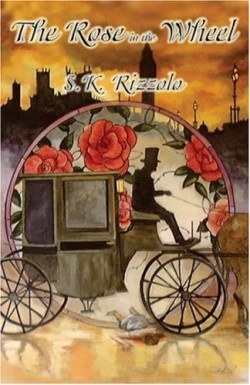The Rose in the Wheel
It is London, England in 1811. Society is enormously class-conscious: the roles of men, women, and various
class strata are clearly delineated. Society is so strictly layered that some people-women especially-can be punished or imprisoned for working the job of a man.
A woman lies strangled in the street, eyes fixed on a stained-glass window of St. Catherine’s church, a window depicting the wheel on which St. Catherine was martyred. A carriage lurches forward and runs over the woman.
And so begins this layered, atmospheric historical mystery. The murder victim was Constance Tyrone, the daughter of a baronet. In deference to her father’s wishes, Constance had agreed to have her portrait painted by one Jeremy Wolfe. In defiance of family and the conventions of the time, Constance had organized a sort of charitable group, taking care of the homeless and less privileged, especially women. During the course of an initial investigation into her death and the Coroner’s inquest, some of Wolfe’s sketches-supposedly erotic sketches-of Constance Tyrone come to light. Wolfe is immediately thrown into prison, the primary suspect.
The case is then unofficially investigated by Penelope Wolfe, Jeremy’s estranged wife. It’s not much of a marriage, and Penelope agrees that Jeremy is a rogue and scoundrel, but doesn’t believe he would murder anyone. Besides, he had been with her and their daughter at the time of the murder, begging her for money.
The official investigation is conducted by the inquisitive Bow Street detective John Chase and attorney Edward Buckler, who is urged to do the work for free to serve the cause of justice, a somewhat foreign concept in 1811 England. With reluctance Buckler agrees. The story primarily weaves around these three investigators, while an unseen group of possible social revolutionaries pulls strings on Jeremy Wolfe’s behalf.
The author was born in Aspen, Colorado and raised in Saudi Arabia and Libya. She returned to the U.S. to earn a masters? degree in literature, and now teaches high school English in Los Angeles. The Rose in the Wheel, her first novel, wheels in and out of the best and worst parts of London, provides rich color and period detail, and successfully transports the reader to nineteenth-century England, complete with archaic, stilted dialogue. The novel succeeds reasonably well as a mystery, but far better as a detailed examination of the social mores of the time period.
Reviewed by
Mark Terry
Disclosure: This article is not an endorsement, but a review. The publisher of this book provided free copies of the book to have their book reviewed by a professional reviewer. No fee was paid by the publisher for this review. Foreword Reviews only recommends books that we love. Foreword Magazine, Inc. is disclosing this in accordance with the Federal Trade Commission’s 16 CFR, Part 255.

